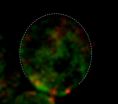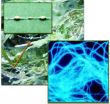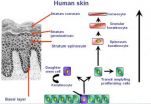(Press-News.org) KANSAS CITY, MO – Over the past several years, Rong Li, Ph.D., at the Stowers Institute for Medical Research has been making crucial discoveries about the development of cell polarity—the process by which one side of a cell becomes different from the other side. Such polarity is critical for the functioning of the vast majority of cells. The outside surface of skin cells is very different from the surface inside the body, for example, while nerve cells have delicately branching dendrites on one end and axons on the other. Li's lab studies yeast cells, which form a unique polarized site, the location of the future bud.
In previous work, Li and others figured out the basic biochemical mechanism underlying cell polarity. The key regulator is a protein called Cdc42. In a non-polarized cell, Cdc42 molecules are randomly distributed around the membrane, like pebbles scattered on a beach. But some parts of the membrane contain a bit more Cdc42 than others. When the regulatory protein is activated, it stimulates the formation of a skeleton of actin filaments that guide Cdc42 in the cytoplasm towards the Cdc42 that's already in the membrane. Mathematical modeling shows that this process is able to concentrate the molecule in those areas, creating a spot—called the polar cap—where yeast cells will bud. "The model worked very well, but it was simplified," says Li.
Now, using cutting-edge microscopy and more sophisticated mathematical modeling, Li's lab has discovered surprising new details about this process. In the January 22, 2013 issue of the online journal Nature Communications, Stowers Research Advisers Brian Slaughter, Ph.D, Jay Unruh, Ph.D., and Boris Rubinstein, Ph.D., along with Li and graduate students Arupratan Das and Sarah Smith report that the development of polarity depends upon "sticky" regions in the membrane that slow the normal rate of diffusion of Cdc42.
"We did not expect that plugging non-uniform diffusion into the mathematical simulation would make that much difference," says Slaughter, one of the paper's first authors. "But tweaking one parameter made all the difference in the world."
The findings have wide-ranging implications. The normal rate of diffusion is much faster in plant and mammalian cells than in yeast cells, suggesting that these sticky spots must play an even greater important role in animals and plants than in yeast. "Our model could apply to a lot of systems," explains Li, who is also a professor in the Department of Molecular and Integrative Physiology at the University of Kansas Medical Center. "It would be very interesting to explore this in mammalian cells."
The new work also highlights some of the unique strengths of the Stowers Institute. Unlike most biomedical research facilities, Stowers employs scientists called research advisors who act like internal freelance consultants, bringing special expertise to a variety of Stowers' labs and projects. Research Advisors Slaughter and Unruh, for instance, are experts in imaging. In this project, they used advanced microscopy to spot single photons (or particles of light) coming from molecules with fluorescent tags as those molecules moved around in living cells. That revealed the presence of the sticky spots. Unruh then modeled the "stickiness" of these spots in a complex numerical simulation while another research advisor, Boris Rubinstein, a physicist in training, brought his mathematical skills to the modeling effort in the form of an analytical model. Thanks to the capabilities at the Stowers Institute, "we can count molecules and measure their diffusion in the living cell," says Li. "Then, combining those measurements with mathematical modeling is very powerful."
The central challenge for creating polarized cells is keeping the Cdc42 molecules concentrated in one spot on the membrane. As Li's team originally discovered, a small excess of Cdc42 in one area stimulates the formation of actin filaments within the cell that then bring more Cdc42 to the spot—even as molecules already in the membrane are diffusing away. Imagine that region of the membrane is a prison and the Cdc42 molecules are prisoners, says Li: "The prisoners escape from prison and the police catch them and put them back." For polarity to develop, recaptures have to happen faster than escapes.
What complicates this picture is that for the particular mechanism of cell polarization being studied, the Cdc42 that is brought to the cell membrane along the actin filaments is not in the form of free-floating molecules. Instead, the Cdc42 is embedded in the membranes of vesicles, which are small bubbles inside cells. When vesicles reach the cell membrane, the vesicle and cell membranes join together in a process called exocytosis. As a result, Cdc42 from the vesicle membrane ends up in the cell membrane. However, in an opposite process, called endocytosis, sections of cell membrane can bulge inward, forming a new vesicle that pinches off and floats into the cell. That process thus can snatch Cdc42 molecules out of the cell membrane to recycle them back to the polar cap.
But building a polar cap requires vesicles with lots of Cdc42 in their membranes. As the vesicles fuse with the cell membrane, those with high Cdc42 concentrations quickly get used up. Soon, the remaining vesicles have so little Cdc42 that when they get inserted in the cell membrane, the concentration of Cdc42 drops. The result: polarization can't be stably maintained, as shown by a model developed by researchers in the Lew lab at Duke University. So Li and her team set out to figure out what is really happening in cells. Using advanced microscopy, the researchers looked at the rate of movement of Cdc42 at the sites of exocytosis and endocytosis on the cell membrane.
The painstaking experimental work turned up two crucial new details. First, the process of endocytosis, which theoretically could remove Cdc42 from the developing polar cap, occurs in small regions adjacent to, but not overlapping with, areas where Cdc42 is delivered. More important, the section of the membrane where Cdc42 accumulates gets "sticky", trapping the master polarity regulator and keeping it from rapidly diffusing away. When Li's team put these details—the diffusion trap and the targeted endocytosis—into the mathematical model, "the model turned out to work beautifully," says Li.
INFORMATION:
The study was funded by the Stowers Institute for Medical Research and the National Institutes of Health (R01 GM057063).
About the Stowers Institute for Medical Research
The Stowers Institute for Medical Research is a non-profit, basic biomedical research organization dedicated to improving human health by studying the fundamental processes of life. Jim Stowers, founder of American Century Investments, and his wife, Virginia, opened the Institute in 2000. Since then, the Institute has spent over 900 million dollars in pursuit of its mission.
Currently, the Institute is home to nearly 550 researchers and support personnel; over 20 independent research programs; and more than a dozen technology-development and core facilities.
A diffusion trap
2013-01-22
ELSE PRESS RELEASES FROM THIS DATE:
Synchrotron infrared unveils a mysterious microbial community
2013-01-22
In the fall of 2010, Hoi-Ying Holman of the U.S. Department of Energy's Lawrence Berkeley National Laboratory (Berkeley Lab) was approached by an international team researching a mysterious microbial community discovered deep in cold sulfur springs in southern Germany.
"They told me what they were doing and said, 'We know what you contributed to the oil-spill research,'" recalls Holman, who heads the Chemical Ecology group in Berkeley Lab's Earth Sciences Division. "They wondered if I could help them determine the biochemistry of their microbe samples."
Holman had ...
Immune cells engineered in lab to resist HIV infection, Stanford study shows
2013-01-22
STANFORD, Calif. — Researchers at the Stanford University School of Medicine have found a novel way to engineer key cells of the immune system so they remain resistant to infection with HIV, the virus that causes AIDS.
A new study describes the use of a kind of molecular scissors to cut and paste a series of HIV-resistant genes into T cells, specialized immune cells targeted by the AIDS virus. The genome editing was made in a gene that the virus uses to gain entry into the cell. By inactivating a receptor gene and inserting additional anti-HIV genes, the virus was blocked ...
Sex of early birds suggests dinosaur reproductive style
2013-01-22
In a paper published in Nature Communications on January 22, 2013, a team of paleontologists including Dr. Luis Chiappe, Director of the Natural History Museum of Los Angeles County's (NHM) Dinosaur Institute, has discovered a way to determine the sex of an avian dinosaur species.
Confuciusornis sanctus, a 125-million-year-old Mesozoic bird, had remarkable differences in plumage — some had long, almost body length ornamental tail feathers, others had none — features that have been interpreted as the earliest example of avian courtship. However, the idea that male Confuciusornis ...
The skin aging regulator
2013-01-22
These mechanisms, described in vivo in mice, engage molecule CD98hc, which is involved in epidermis renewal and could be an indicator of the skin's capacity for regeneration.
The results were published in the Journal of Experimental Medicine review.
The epidermis, the surface layer of the skin, is mainly composed of keratinocytes cells, which, in humans, are renewed continuously over a 21-day cycle. These cells are located on a membrane made up of components from the extracellular matrix that provides the junction with the dermis, the deep layer of the skin (see diagram). ...
Harmful effects of bisphenol A proved experimentally
2013-01-22
Bisphenol A (BPA) is a chemical compound that is included in the composition of plastics and resins. It is used, for example, in the manufacture of food containers such as bottles and babies' feeding bottles. It is also found in the protective films used inside food and drink cans and on till receipts where it used as a discloser. Significant levels of BPA have also been found in human blood, urine, amniotic fluid and placentas. Recent studies have shown that this industrial component has harmful effects on reproductive ability, development and the metabolism of laboratory ...
Analysis of fracking wastewater yields some surprises
2013-01-22
DURHAM, N.C. -- Hydraulically fractured natural gas wells are producing less wastewater per unit of gas recovered than conventional wells would. But the scale of fracking operations in the Marcellus shale region is so vast that the wastewater it produces threatens to overwhelm the region's wastewater disposal capacity, according to new analysis by researchers at Duke and Kent State universities.
Hydraulically fractured natural gas wells in the Marcellus shale region of Pennsylvania produce only about 35 percent as much wastewater per unit of gas recovered as conventional ...
EARTH: The dangers of solar storms
2013-01-22
Alexandria, VA – Throughout history, humanity has steadily increased its dependence upon technology. Although technology has vastly improved the quality of life for billions of people, it has also opened us up to new risks and vulnerabilities. Terrorism and natural disasters might be at the forefront of the minds of policymakers and the U.S. population, but a significant threat lurks over our heads: the sun. A massive solar storm, the size last seen a century and a half ago, could easily leave hundreds of millions of people in the dark for days, weeks or even months.
The ...
Unprecedented glacier melting in the Andes blamed on climate change
2013-01-22
Glaciers in the tropical Andes have been retreating at increasing rate since the 1970s, scientists write in the most comprehensive review to date of Andean glacier observations. The researchers blame the melting on rising temperatures as the region has warmed about 0.7°C over the past 50 years (1950-1994). This unprecedented retreat could affect water supply to Andean populations in the near future. These conclusions are published today in The Cryosphere, an Open Access journal of the European Geosciences Union (EGU).
The international team of scientists – uniting researchers ...
How can evolutionary biology explain why we get cancer?
2013-01-22
Over 500 billion cells in our bodies will be replaced daily, yet natural selection has enabled us to develop defenses against the cellular mutations which could cause cancer. It is this relationship between evolution and the body's fight against cancer which is explored in a new special issue of the Open Access journal Evolutionary Applications.
"Cancer is far from a single well-defined disease which we can identify and eradicate," said Dr Athena Aktipis, Director, Human and Social Evolution, Center for Evolution and Cancer at the University of California, San Francisco. ...
Children with egg allergies can safely receive flu vaccine, U-M study says
2013-01-22
Ann Arbor, Mich. — Egg allergic children, including those with a history of anaphylaxis to egg, can safely receive a single dose of the seasonal influenza vaccine, according to a new study from the University of Michigan.
Historically, the CDC recommended that the seasonal influenza vaccine not be administered to egg allergic children. Recent research conducted at the University of Michigan, and elsewhere, helped modify this recommendation in 2011 so that caution was warranted for only those with severe egg allergy.
The new study, published in the Annals of Allergy, ...


